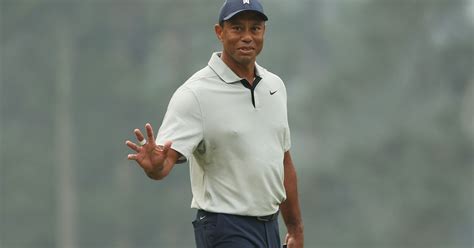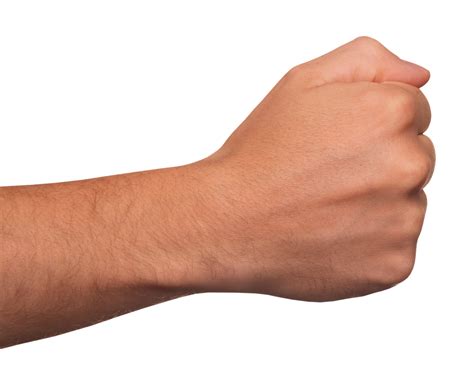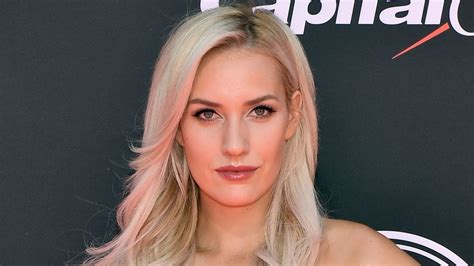
Paige Spiranac jokingly suggested her “less clothes, better golf” theory after struggling on the course, sparking online discussion about her brand and impact.
Professional golfer and social media personality Paige Spiranac humorously alluded to her “less clothes, better golf” theory following a challenging round, a remark that quickly ignited conversations about her unique brand and its influence on the sport. The comment, delivered with her characteristic wit, served as a reminder of the criticism and support she receives for her approach to promoting golf.
Spiranac, who has amassed a significant following on social media platforms like Instagram and X (formerly Twitter), often incorporates eye-catching attire into her golf content. While some appreciate her efforts to broaden golf’s appeal, others contend that her image overshadows her accomplishments and potentially detracts from the sport’s traditional values. This latest quip has reopened the debate regarding the intersection of image, performance, and influence in the world of golf.
“Sometimes I play my best golf when I’m wearing the least,” Spiranac posted on X, tongue-in-cheek, after a recent round that didn’t meet her expectations. While Spiranac did not specify when and where this event happened, it is clear that her golf play did not meet her expectations that day.
Spiranac’s career, which includes a brief stint in professional golf before transitioning to media and content creation, has been marked by both accolades and controversy. She won the CWGA Junior Stroke Play in 2010 and the 2012 Colorado Women’s Golf Association Match Play. Her large social media following has allowed her to partner with various brands and create her own subscription-based platform, OnlyPaige. However, it has also subjected her to criticism, with some accusing her of leveraging her appearance more than her golfing skills.
Her influence on the sport extends beyond her playing career. Spiranac has actively advocated for inclusivity in golf and has spoken out against body shaming and online harassment. She uses her platform to promote body positivity and encourages more women to take up the sport. However, her approach remains a point of contention, with some arguing that it perpetuates a focus on appearance rather than athletic ability.
The recent “less clothes, better golf” remark underscores the ongoing tension surrounding Spiranac’s public persona. While delivered in jest, it highlights the complex dynamic between her image, her golf career, and the broader perception of women in sports.
Spiranac’s ability to generate conversation and engagement is undeniable. Her approach has attracted a new audience to golf, particularly younger fans and women, which some view as a positive development for a sport often perceived as exclusive and traditional. However, the debate about whether her methods ultimately benefit or detract from the sport continues.
One of the key arguments against Spiranac’s approach is that it sexualizes women in golf and reinforces the idea that appearance is more important than skill. Critics argue that this can be detrimental to aspiring female golfers who may feel pressured to conform to certain beauty standards to gain attention and recognition. They believe that focusing on appearance distracts from the hard work and dedication required to succeed in the sport.
On the other hand, supporters argue that Spiranac is simply using her platform to promote golf in her own unique way. They contend that she is not harming anyone and that her approach is ultimately harmless. Some even argue that her confidence and willingness to challenge traditional norms are empowering to women.
The debate surrounding Spiranac also raises broader questions about the role of social media in sports and the increasing pressure on athletes to cultivate a personal brand. In today’s digital age, athletes are no longer just judged on their performance on the field or course, but also on their ability to connect with fans and build a following online. This can create a situation where athletes feel compelled to prioritize their image over their athletic development.
Spiranac’s career highlights the complexities of navigating this new landscape. While her social media presence has undoubtedly opened doors for her, it has also made her a target for criticism and scrutiny. Her ability to manage this tension and continue to promote golf in her own way will likely shape her legacy in the sport.
The online reaction to Spiranac’s latest comment has been varied, with some users expressing support and amusement, while others have criticized her for perpetuating stereotypes. This division reflects the broader debate surrounding her brand and its impact on golf. Whether her approach is ultimately beneficial or detrimental to the sport remains a matter of ongoing discussion. What’s undeniable is her ability to generate discussion and engagement, highlighting the evolving dynamics of sports and social media in the 21st century.
Paige Spiranac remains a prominent figure in the golf world, both on and off the course. Her impact, while debated, is undeniable, sparking conversations about image, performance, and the future of golf in the digital age. The “less clothes, better golf” remark, whether serious or in jest, encapsulates the ongoing discussion surrounding her brand and its influence on the sport.
The controversy surrounding Spiranac’s approach highlights a broader issue within the sports industry: the objectification of female athletes. For decades, women in sports have faced pressure to conform to specific beauty standards in order to gain recognition and sponsorship opportunities. This pressure can lead to body image issues, eating disorders, and a focus on appearance rather than athletic performance.
Spiranac has addressed this issue on several occasions, using her platform to promote body positivity and challenge traditional beauty standards. She has spoken out against online harassment and body shaming, encouraging her followers to embrace their natural bodies and focus on their health and well-being. However, some critics argue that her own approach, which often involves wearing revealing clothing, undermines her efforts to combat objectification.
The debate about Spiranac’s impact also raises questions about the role of social media in shaping perceptions of athletes. In the past, athletes were primarily judged on their performance on the field or course. Today, however, social media has created a new platform for athletes to connect with fans and build a personal brand. This can be a positive development, allowing athletes to reach a wider audience and generate more revenue. However, it can also create pressure to conform to certain trends and maintain a curated image.
Spiranac has successfully leveraged social media to build a large following and generate significant income. However, she has also faced criticism for using her platform to promote her appearance rather than her athletic skills. Some argue that this approach perpetuates a focus on superficiality and undermines the achievements of female athletes who prioritize performance over appearance.
Despite the controversy surrounding her approach, Spiranac has undoubtedly had a positive impact on the golf industry. She has attracted a new audience to the sport, particularly younger fans and women, and has helped to break down some of the traditional barriers that have historically excluded these groups. She has also used her platform to promote important causes, such as body positivity and mental health awareness.
The future of Spiranac’s career remains uncertain. She may continue to focus on social media and content creation, or she may decide to return to competitive golf. Whatever path she chooses, she is likely to remain a controversial figure in the sport. Her impact, whether positive or negative, is undeniable, and her story serves as a reminder of the complex challenges facing female athletes in the modern era.
The focus on image and appearance in sports, especially for female athletes, extends beyond individual cases like Spiranac’s. It reflects systemic issues within the industry, including media coverage, sponsorship deals, and fan expectations. Studies have shown that female athletes are often judged more on their appearance than their male counterparts, and they receive less media attention overall. This disparity can create a self-perpetuating cycle, where female athletes feel pressure to conform to certain beauty standards in order to gain visibility and recognition.
The issue of sponsorship deals is particularly relevant. Many female athletes rely on sponsorships to support their careers, but these deals often prioritize appearance over athletic performance. Companies may be more likely to sponsor athletes who are considered attractive or marketable, even if they are not the most successful in their sport. This can create a situation where female athletes feel pressured to focus on their appearance in order to secure sponsorships.
The role of social media in exacerbating these issues cannot be ignored. While social media can be a powerful tool for athletes to connect with fans and build a personal brand, it can also create a platform for online harassment and body shaming. Female athletes are often targeted with sexist and misogynistic comments, and they may feel pressured to conform to unrealistic beauty standards in order to avoid criticism.
Addressing these systemic issues requires a multi-pronged approach. Media outlets need to provide more equitable coverage of female athletes, focusing on their athletic achievements rather than their appearance. Sponsorship deals need to prioritize performance over appearance, ensuring that female athletes are rewarded for their athletic skills. Social media platforms need to take stronger action against online harassment and body shaming, creating a safer and more inclusive environment for female athletes.
Ultimately, the goal is to create a sports industry where female athletes are valued for their athletic abilities and not judged on their appearance. This requires a shift in cultural attitudes and a commitment to promoting gender equality in sports. While individuals like Spiranac may continue to spark debate about the intersection of image and performance, it is important to recognize that these issues are part of a larger systemic problem that needs to be addressed.
The long-term consequences of prioritizing image over performance in sports can be significant. It can lead to a decline in female participation rates, as young girls may be discouraged from pursuing athletic careers if they feel they don’t meet certain beauty standards. It can also create a toxic environment for female athletes, where they feel pressured to conform to unrealistic expectations and constantly worry about their appearance.
Furthermore, the focus on image can detract from the true value of sports, which is about athletic achievement, teamwork, and personal development. When athletes are judged more on their appearance than their performance, it undermines the integrity of the sport and sends the wrong message to young people.
Creating a more equitable and inclusive sports industry requires a collective effort from athletes, coaches, administrators, media outlets, and fans. Athletes can use their platforms to speak out against sexism and promote body positivity. Coaches can create a supportive environment for their athletes, focusing on their athletic development and mental well-being. Administrators can implement policies that promote gender equality and protect athletes from harassment. Media outlets can provide more equitable coverage of female athletes, focusing on their athletic achievements. Fans can support female athletes and challenge sexist comments and attitudes.
By working together, we can create a sports industry that values all athletes, regardless of their gender or appearance. This will not only benefit female athletes but also enrich the entire sports community. The debate surrounding Paige Spiranac and her approach serves as a reminder of the ongoing challenges and opportunities in the pursuit of gender equality in sports.
Spiranac’s brand and the surrounding discussions also highlight the evolution of sports marketing. Traditional endorsements focused primarily on athletic performance and alignment with brand values. Now, social media presence, personality, and relatability are increasingly important factors. This shift presents both opportunities and challenges for athletes. It allows them to connect directly with fans, build their own brand, and potentially earn more income. However, it also requires them to be savvy marketers and constantly manage their online image.
For female athletes, the pressure to cultivate a marketable image can be particularly intense. They may feel compelled to conform to certain beauty standards or adopt a specific persona in order to attract sponsors and fans. This can create a conflict between authenticity and marketability, as athletes may feel they need to compromise their values or beliefs in order to succeed.
The debate surrounding Spiranac’s approach raises questions about the ethics of sports marketing and the responsibility of athletes to use their platforms in a positive way. Some argue that athletes have a duty to be role models and promote healthy values. Others argue that athletes have the right to express themselves freely and pursue their own financial interests.
Ultimately, the line between ethical marketing and exploitation is subjective and depends on individual values. However, it is important for athletes to be aware of the potential consequences of their marketing decisions and to consider the impact they may have on others, particularly young people.
The changing landscape of sports marketing also presents opportunities for innovation and creativity. Athletes can use social media to connect with fans in new and engaging ways, creating unique content and building a loyal following. They can also partner with brands that align with their values and support causes they believe in.
The future of sports marketing is likely to be more personalized and authentic, with athletes playing a greater role in shaping their own brand and connecting with fans on a deeper level. This will require athletes to be more than just skilled performers; they will also need to be savvy marketers, communicators, and community builders.
Paige Spiranac’s career exemplifies this trend, as she has successfully leveraged social media to build a personal brand that resonates with a large audience. While her approach may be controversial, it is undeniable that she has changed the way athletes are marketed and perceived in the digital age.
Frequently Asked Questions (FAQs)
1. What is Paige Spiranac’s “less clothes, better golf” theory?
Paige Spiranac’s “less clothes, better golf” theory is a tongue-in-cheek remark she made on social media, implying that she plays better golf when wearing less clothing. It’s a humorous comment that references both her fashion choices on the golf course and the criticism she sometimes receives for them. It’s not a scientifically proven theory but rather a lighthearted observation.
2. Why is Paige Spiranac a controversial figure in the golf world?
Spiranac is controversial due to her unconventional approach to promoting golf, which often involves wearing revealing outfits and focusing on her appearance on social media. Some critics argue that this sexualizes women in golf and detracts from the sport’s traditional values, while others believe she’s broadening golf’s appeal and empowering women.
3. What are some of Paige Spiranac’s accomplishments in golf?
Prior to her career as a social media personality, Spiranac had some success as a golfer. She won the CWGA Junior Stroke Play in 2010 and the 2012 Colorado Women’s Golf Association Match Play. She also played college golf at the University of Arizona and San Diego State University.
4. What is OnlyPaige, and what does it offer?
OnlyPaige is Spiranac’s subscription-based platform where she offers exclusive content, including golf tips, behind-the-scenes looks at her life, and other lifestyle content. It allows her to connect directly with her fans and monetize her brand in a more controlled environment.
5. How has Paige Spiranac impacted the sport of golf?
Spiranac’s impact is debated. Supporters say she has brought a new audience, particularly younger fans and women, to golf and has challenged traditional norms. Critics argue that she promotes superficiality and objectifies women. Regardless, her large social media following and media presence have undoubtedly raised the profile of golf and sparked conversations about its future.









